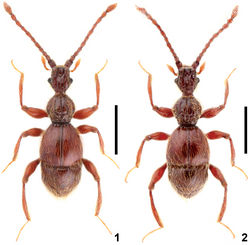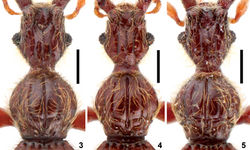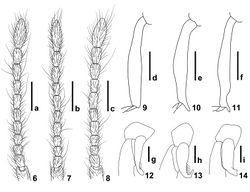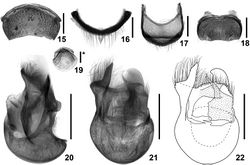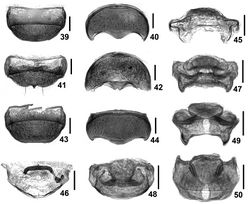Intestinarius guangdongensis
| Notice: | This page is derived from the original publication listed below, whose author(s) should always be credited. Further contributors may edit and improve the content of this page and, consequently, need to be credited as well (see page history). Any assessment of factual correctness requires a careful review of the original article as well as of subsequent contributions.
If you are uncertain whether your planned contribution is correct or not, we suggest that you use the associated discussion page instead of editing the page directly. This page should be cited as follows (rationale):
Citation formats to copy and paste
BibTeX: @article{Yin2011ZooKeys116, RIS/ Endnote: TY - JOUR Wikipedia/ Citizendium: <ref name="Yin2011ZooKeys116">{{Citation See also the citation download page at the journal. |
Ordo: Coleoptera
Familia: Staphylinidae
Genus: Intestinarius
Name
Intestinarius guangdongensis Yin and Li sp. n. – Wikispecies link – ZooBank link – Pensoft Profile
Type locality
Nan-ling National Nature Reserve, Guangdong Province, South China
Type material
(7 ♂♂, 5 ♀♀). Holotype: ♂, labelled ‘CHINA: guangdong Prov. / Shaoguan City / Nanling National N. R. / 09.viii.2010 / Li-Zhen LI leg.’; Paratypes: 6 ♂♂, 5 ♀♀, same label data as holotype.
Description
Measurements: male (female). BL 2.62–2.72 (2.40–2.56), HL 0.58–0.63 (0.58–0.60), HW 0.52–0.55 (0.49–0.50), PL 0.56–0.58 (0.55–0.56), PW 0.58–0.59 (0.53–0.57), EL 0.87–0.89 (0.77–0.78), EW 0.93–0.94 (0.84–0.88), AL 0.61–0.62 (0.50–0.62), AW 0.83–0.85 (0.80–0.81). Length of aedeagus 0.41. Width of female genitalia 0.32.
Male (Fig. 1). Reddish-brown, maxillary palpi and tarsi lighter. Head, pronotum and elytra covered with long setae. Head (Fig. 3) slightly longer than wide. Clypeus short in dorsal view, roundly arcuate on anterior margin; frons markedly impressed between profoundly raised antennal tubercles; vertexal foveae situated backwards, vertexal sulci extended from vertexal foveae to frons; carinae lateral to the vertexal sulci derived from base of antennal tubercles well-defined; occipital carina reaching posterior margin of frontal impression; postocular margins moderately long, nearly straight, gradually narrowed toward base. Eyes well-developed, each comprised of about 25 facets. Fourth palpomere of maxillary palpi with tuft of dense and fine external setae. Gular carina not conjoint with gular fovea. Antennae as in Fig. 6. Pronotum (Fig. 3) about as long as wide, median longitudinal sulcus extended beyond transverse antebasal sulcus, two lateral longitudinal sulci well-defined, exterior one born from lateral antebasal foveae; two pairs of basolateral foveae and two pairs of antebasal conical tubercles well-defined. Each elytron with three basal foveae and complete sutural stria; discal stria short, reaching less than half of elytral length. Mesotrochanters slightly protuberant on posterior margin, mesotibiae without apical protuberance; metatrochanters modified (Fig. 12), setose on posterior margin.
Abdomen with tergite IV largest, V–VI about same length and successively narrowed, tergite (Figs 15–16) VII modified, provided with median small round impression, tuft of long setae directed toward posterior margin; tergite VIII as in Fig. 17; sternite VIII as in Fig. 18; sternite IX as in Fig. 19; aedeagus as in Figs 20–22.
Female. Slightly smaller than male; each eye comprised of about 15 facets; maxillary palpi, legs and tergite VII lacking modifications; tergite VIII as in Fig. 39; sternite VIII as in Fig. 40; female genitalia as in Figs 45–46. Distribution. Known only from the type locality.
Etymology. The species is named after its type locality.
Ramarks. The modified maxillary palpomere IV of the new species is shared only with Intestinarius quinquesulcatus, type species of the genus, described from Singapore and Maylasia; the unmodified male mesotibiae is similar to that of Intestinarius orthopygium (Laos); the modified metatrochanters resemble those of Intestinarius distorticeps (Jawa), Intestinarius quinquesulcatus, Intestinarius kuzmini (Yunnan, China), Intestinarius orthopygium, Intestinarius crassicornis (Laos) and Intestinarius longiceps sp. n. (Guizhou, China); the modified tergite VII also occurs in most species of the genus except for Intestinarius distorticeps and Intestinarius pexatus. Intestinarius guangdongensis may be dintinguished from all its congeners by a combination of the following characters: simple mesotibiae, shape of modified metatrochanters and shape of sternite VIII in male, shape of female tergite and sternite VIII and genital organs of both sexes.
One female specimen has tergite VII with median protuberance, but it is identical to other females in all characters including female genitalia. Thus, females of this species are most probably polymorphic in this character. Such polymorphism in Intestinarius kuzmini was also observed in Kurbatov (2007: 284) and in the present study (see remarks under Intestinarius kuzmini).
Original Description
- Yin, Z; Li, L; Zhao, M; 2011: On the Chinese species of the genus Intestinarius Kurbatov (Coleoptera, Staphylinidae, Pselaphinae) ZooKeys, 116: 15-24. doi
Images
|
